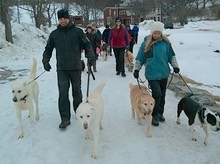
Tonight I was approached by a student of mine to discuss how proud she was with the progress she and her dog have made in the last two months. I wanted to share the discussion with everybody in the hopes that it helps people in their own training efforts. First a little bit of background.
This couple adopted their dog from Humane Services. It was a young boxer who, while being very cute, was also very energetic, rude and playful. They quickly fell in love with their new dog and wanted to do what was best for her. They enrolled her into training at another facility and quickly realized that while the training they were receiving was valuable, it was not addressing one of their main concerns…that being their little angel was reactive to other dogs and people. Upon seeing other dogs, their dog lunged and barked aggressively at them. Upon people visiting their home, their dog was ok with some but nipped at others. The training program they were enrolled in had the owners and their dogs working in aisles in the facility. They only time they actually came into eye contact with other dogs or their owners was upon entering and leaving the facility. Therefore, the problem was not being addressed.
They completed the training program but things were getting worse. The couple contacted me, and we set up a one on one. I set them up with a behaviour modification plan to help rectify the situation that included measures of counter conditioning and desensitization. It included enrolling in my program and attending the weekly group dog walks in the behaviour modification plan. The female owner is alone with the dog as her boyfriend is in another province so it has been left to her to complete the training and deal with the issue. All of this while she maintains a full time demanding job.
I am glad to report she stepped up to the plate big time. She has worked through the behaviour modification plan, has attended almost every group dog walk and is half way through the course. I could see the results as they were evident over the weeks since I first met their dog. Last night, she came to me and related how great it was to be able to relax with her dog. She stated she is no longer scared when people come to her house. She no longer feels tense walking her dog, that her dog is actually showing interest in other dogs and while they still have a ways to go, they are getting there.
I tell this story because I hear people all the time looking for quick fixes for their dog’s behaviours. Most times quick fixes do not exist or if they do, they are ineffectual and do not last long term. Change, true change, takes time, patience and understanding. It takes commitment. You have to realize that setbacks occur and be prepared for them. You also have to realize that when setbacks do occur, they are temporary and can be worked through. Learning how to communicate properly with your dog and develop a relationship of trust is key to development and change. Too often, we humans get caught up in sets of arbitrary rules and pseudo psycho babble to guide our interactions with our four legged companions. These rules and babble do nothing but confuse our dogs. It damages the relationship and trust our dog should have in us. We buy into these things because we are told that “dogs are dogs and need to be treated like dogs”. Usually statements like this are followed by some reference to dominance and establishing proper pack structure much of which I wish would die the death it deserves.
For those who have read my blogs and heard me talk in class, you realize that most of that information is utter garbage at least in the way it is interpreted and used by people. I have to admit, that when I first started training, I was guilty of buying into some of it. It was an easy way to understand and communicate things and people accepted it readily. Unfortunately, it was also very wrong. I realized what a mistake it was and have adopted other ways of doing things. I say in class all of the time, the goal of my instruction is to teach you to communicate effectively with your dog. If you have effective communication happening, the sky is the limit on what you can teach. Know how to interrupt a dog’s undesirable behaviour and even more importantly, know how and when to effectively and consistently reinforce a dog’s desirable behavior. This consistency is key. Lack of consistency leads to confusion. Many times dogs are not doing what they are asked to do, not because they are being “stubborn” or “dominant” but because we have done a poor job in teaching them how. In other words, we have done a poor job of communicating properly with them. Once you get this type of proper communication happening, the world of possibility opens up as to what can occur.
These types of skills take time to develop. They do not happen over night. They take a lot of practice and work but as with the above example, the results are well worth the effort. Work on achieving them, you will have a much happier dog and you will be a much happier owner.